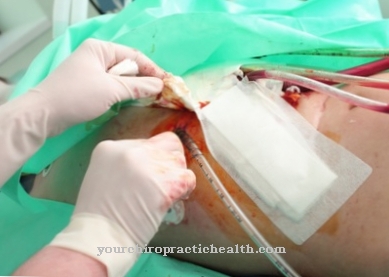Under one Thyroidectomy is understood the surgical removal of the thyroid gland. This is mostly done to treat goiter or thyroid cancer.
What is the thyroidectomy?
With thyroidectomy or Thyroidectomy is the surgical removal of the thyroid gland (thyroid gland). If the operation is only unilateral, it is called a hemithyroidectomy.
If the thyroid gland is only partially removed, doctors speak of a goiter resection. In this way, the remaining functional part of the organ remains in the body. A thyroid resection was performed for the first time in 1791 by the French doctor Pierre-Joseph Desault (1744-1795). The first thyroidectomy in Germany was performed by the surgeon Ludwig Rehn (1849-1930) in 1880.
A thyroidectomy can treat both benign and malignant diseases of the thyroid gland. If metastases (daughter tumors) already exist as part of a cancer, a so-called neck dissection, in which all cervical lymph nodes are removed, can be carried out in addition to the removal of the thyroid.
Function, effect & goals
A thyroidectomy can be done for a variety of reasons. If there is a benign nodular goiter, the thyroid gland will only be removed if there is a complete nodular change in the organ. In this case it is necessary to remove the entire tissue of the thyroid gland because there is an increased risk of relapse. As a rule, however, only a partial thyroid resection is performed due to the high risk of complications.
Another area of application is the autoimmune disease Graves' disease, which is associated with an overactive thyroid. Both a partial and a complete thyroidectomy can be performed.
Thyroidectomy is often used in cancer of the thyroid gland. These include papillary thyroid carcinoma, follicular thyroid carcinoma, medullary thyroid carcinoma and anaplastic thyroid carcinoma.
Before a thyroid gland can be surgically removed, various check-ups must be carried out in advance. The doctor checks the patient's physical condition. The main focus of control is the heart and circulation. X-rays are also taken of the lungs. The preliminary examinations also include determining the blood count, blood clotting, electrolytes and kidney function. The CRP value is also determined to rule out inflammation. The routine examinations also include determining thyroid hormones. An ear, nose and throat doctor will also check how flexible the patient's vocal cords are.
At the beginning of the thyroidectomy, the patient is given general anesthesia, which is the standard procedure for this procedure. He is also positioned with his upper body slightly erect, while his head leans back into a bowl, which makes it easy to reach the thyroid.
The first step in thyroidectomy is to expose the anterior surface of the thyroid gland. The tissue bridge on the windpipe, which is located between the thyroid lobes, is severed and provided with hemostatic supply. The surgeon then loosens the parts of the thyroid that need to be removed and cuts through the blood vessels responsible for supplying and draining blood. During the procedure, the surgeon ensures that the vocal cord nerves and the parathyroid glands are spared. After cutting through the connective tissue between the windpipe and thyroid gland, the flap is removed.
If the doctor finds metastases on the lymph nodes during the procedure, a radical thyroidectomy including neck dissection must be performed. For this purpose he extends the so-called Kocher collar cut to a door wing cut. He makes a straight longitudinal cut at its center line. This ends below the chin and is widened transversely to both sides.
The next step in the thyroidectomy is the installation of Redon drains to drain blood and wound exudate. The wound is closed in three layers. The surgeon closes muscles and subcutaneous tissue with suture material that is absorbed. To close the skin, the surgeon uses an intracutaneous suture technique, which is considered cheap. Tissue adhesives or adaptive plasters are also possible alternatives.
Risks, side effects & dangers
Thyroidectomy involves some risks. Bleeding can occur during or after the surgical procedure. In some cases, these develop threateningly because the thyroid gland is well supplied with blood.
As a rule, therefore, blood reserves are usually available for use. The good blood circulation has the advantage that purulent wound infections rarely occur. If so, they can be easily identified and treated accordingly. However, the cosmetic result is often negative. Occasionally, post-operative blood clots or embolisms are also possible.
Another possible risk of thyroidectomy is cutting the vocal cords. This results in permanent paralysis of the vocal muscles and hoarseness. Functional failures can also occur due to overstretching or squeezing the nerves. However, the nerves usually recover, so no special treatment is required. A bilateral recurrent palsy, which can lead to a complete obstruction of the trachea, is particularly worrying. This creates the risk that the patient will suffocate. In such cases a permanent tracheotomy is necessary.
Another danger of thyroidectomy is an unintentional injury to the parathyroid glands. It is usually difficult to detect and can derail the calcium metabolism. However, this complication can usually be remedied by adding vitamin D and calcium.
Other possible risks and side effects are difficulty swallowing, neck pain from positioning, injuries to adjacent body structures such as the windpipe or esophagus, soft tissue damage, the formation of scars or allergic reactions that can even result in life-threatening anaphylactic shock.
























.jpg)



